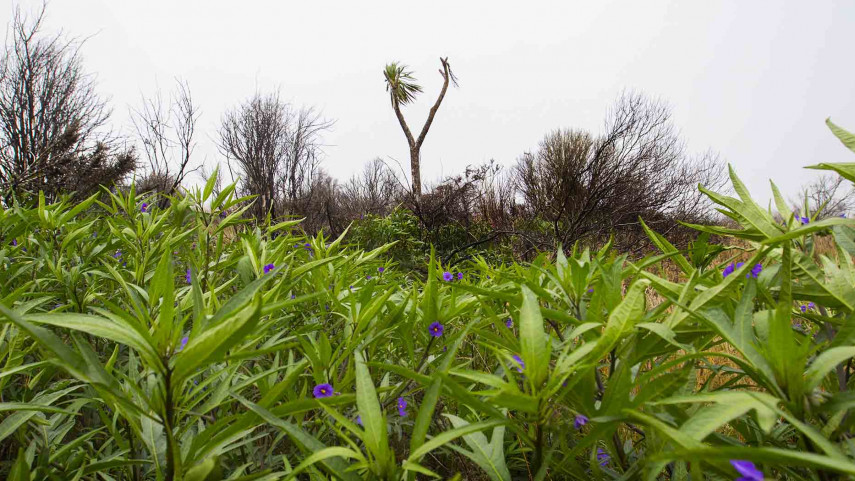
One year on from the Port Hills fires

Share this story
A year on from the devastating Port Hills wildfires, reserve areas hard hit by the smoke and flames are showing encouraging signs of recovery.
Thousands of young trees and seedlings planted after the fires are starting to take hold and other plants are naturally regenerating.
“It’s really encouraging to see how much regeneration has occurred over the past 12 months,’ says Christchurch City Council Port Hills Ranger Di Carter.

Poroporo seedlings are breathing new life into fire hit areas of the Port Hills.
“It was heart-breaking to witness the devastation caused by the fires but it has been heart-warming to see the community come together to help us in our efforts to restore this iconic piece of the Canterbury landscape.’’
The Port Hills wildfires began on Monday 13 February 2017 and at their height covered an area of more than 1600 hectares.
During the massive firefighting effort, helicopter pilot and decorated soldier Steve Askin, who was helping to fight the fire by air, was tragically killed when his helicopter crashed.
Nine homes were loss and five damaged as a result of the fires, which took 66 days to fully extinguish.
The fires burnt into reserve areas on the Port Hills and destroyed 6500 trees that had been planted by volunteers over the past decade.
Since the fires Christchurch City Council Park Rangers have spearheaded a massive replanting effort.
With the support of volunteers they have planted 7200 plants over an area of 1.5 hectares in Marleys Hill Reserve and Kennedys Bush Reserve.
“The new plants are doing brilliantly and have come through the hot summer really well. We’ve had problems with thistle incursions and hares trying to eat the new plants in Kennedys Bush Reserve but 90 to 95 per cent of the plants have managed to survive,’’ she says.
Thanks to the efforts of 15 schools who participated in the “collect, sow and grow poroporo’’ project, about 3000 poroporo seedlings have also been planted in the Port Hills.
“This project was essentially a trial to see how effectively poroporo could be grown and planted densely so it provides a less flammable buffer along road margins. We also wanted to see if we could encourage more rapid regeneration of native species into the surrounding bracken,’’ says Ms Carter.
“The poroporo plants were grown in Coffee Culture cups with Living Earth compost and have survived incredibly well. We’ve lost a few of the smaller seedlings but we have had good success with the larger, more robust seedlings.’’
Ms Carter says the new plants will require regular maintenance over the next few years until they get properly established. Members of the public need to be aware that poroporo berries are poisonous and should not be eaten.
The Council will be looking for volunteers to help with this work in the autumn.
Ms Carter says the focus over the winter months will be on replanting the Kennedys Bush Reserve boundaries with less flammable species of plants.
The plan is to put in about 11,200 plants.
“We’ll be getting volunteers to put in 1800 of the plants but the bulk are intended for planting around the less accessible boundaries of Kennedys Bush Reserve so that work will be done by the rangers,’’ says Ms Carter.
If you are interested in volunteering to help with the ongoing maintenance or planting work on the Port Hills please email Di Carter.
